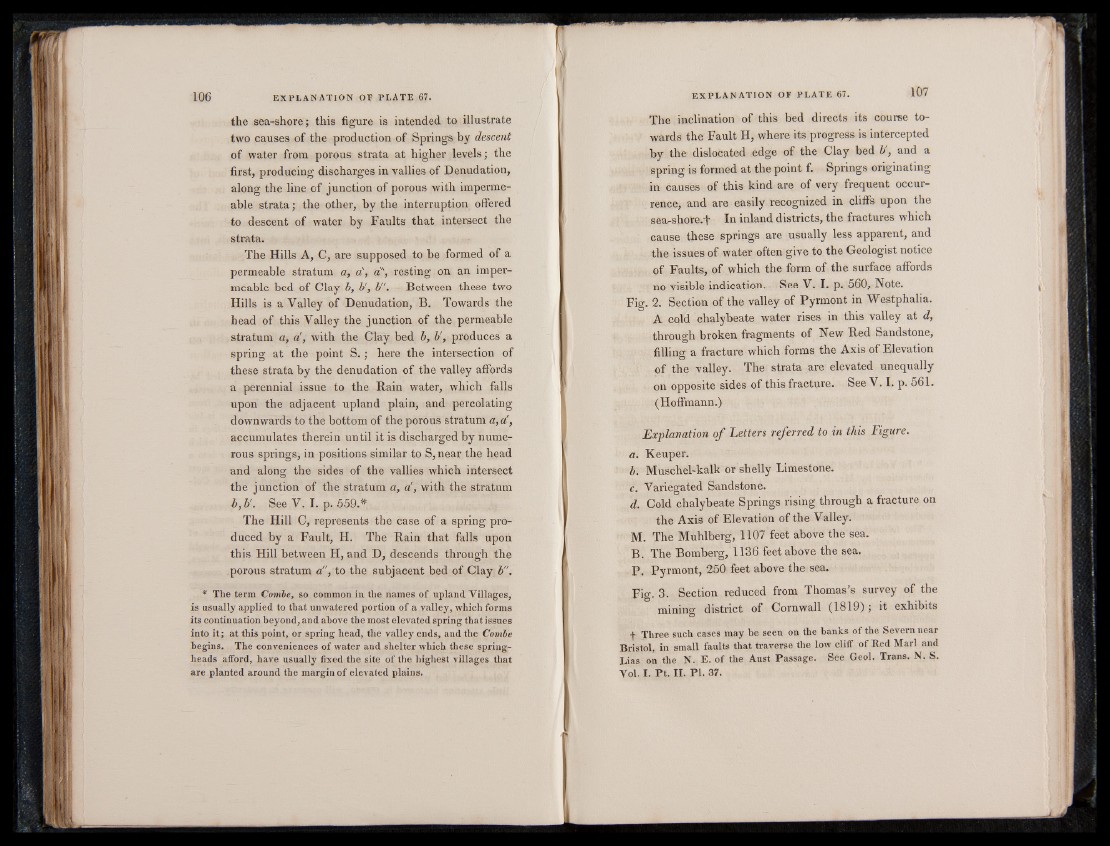
the sea-shore; this figure is intended to illustrate
two causes of the production of Springs by descent
of water from porous strata at higher levels; the
first, producing discharges in vallies of Denudation,
along the line of junction of porous with impermeable
strata; the other, by the interruption offered
to descent of water by Faults that intersect the
strata.
The Hills A, C, are supposed to be formed of a
permeable stratum a, ct, a", resting on an impermeable
bed of Clay b, b', b". Between these two
Hills is a Valley of Denudation, B. Towards the
head of this Valley the junction of the permeable
stratum a, a', with the Clay bed b, b', produces a
spring at the point S. ; here the intersection of
these strata by the denudation of the valley affords
a perennial issue to the Rain water, which falls
upon the adjacent upland plain, and percolating
downwards to the bottom of the porous stratum a,a',
accumulates therein until it is discharged by numerous
springs, in positions similar to S, near the head
and along the sides of the vallies which intersect
the junction of the stratum a, a!, with the stratum
b, b'. See V. I. p. 559.*
The Hill C, represents the case of a spring produced
by a Fault, H. The Rain that falls upon
this Hill between H, and D, descends through the
porous stratum a", to the subjacent bed of Clay b".
* The term Combe, so common in the names of upland Villages,
is usually applied to that unwatered portion of a valley, which forms
its continuation beyond, and above the most elevated spring that issues
into i t ; at this point, or spring head, the valley ends, and the Combe
begins. The conveniences of water and shelter which these springheads
aiford, have usually fixed the site of the highest villages that
are planted around the margin of elevated plains.
The inclination of this bed directs its course towards
the Fault H, where its progress is intercepted
by the dislocated edge of the Clay bed b', and a
spring is formed at the point f. Springs originating
in causes of this kind are of very frequent occurrence,
and are easily recognized in cliffs upon the
sea-shore.f In inland districts, the fractures which
cause these springs are usually less apparent, and
the issues of water often give to the Geologist notice
of Faults, of which the form of the surface affords
no visible indication. See V. I. p. 560, Note.
Fig. 2. Section of the valley of Pyrmont in Westphalia.
A cold chalybeate water rises in this valley at d,
through broken fragments of New Red Sandstone,
filling a fracture which forms the Axis of Elevation
of the valley. The strata are elevated unequally
on opposite sides of this fracture. See V. I. p. 561.
(Hoffmann.)
Explanation of Letters referred to in this Figure.
a. Keuper.
b. Muschel-kalk or shelly Limestone.
c. Variegated Sandstone.
d. Cold chalybeate Springs rising through a fracture on
the Axis of Elevation of the Valley.
M. The Muhlberg, 1107 feet above the sea.
B. The Bomberg, 1136 feet above the sea.
P. Pyrmont, 250 feet above the sea.
Fig. 3- Section reduced from Thomas’s survey of the
mining district of Cornwall (1819); it exhibits
+ Three such cases may be seen on the banks of the Severn near
Bristol, in small faults that traverse the low cliff of Red Marl and
Lias on the N. E. of the Aust Passage. See Geol. Trans. N. S.
Vol. I. Pt. II. PI. 37.